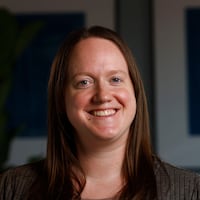The building to be renovated is attached to the school’s Performing Arts Center, but detached from the main high school building by a driveway. It is not currently used for any active learning and has instead served as a place for storage and some athletic locker rooms, according to district spokeswoman Cassie Dietrich.
Makerspace labs — collaborative student work spaces for designing, exploring, making, learning and sharing — will be constructed as permanent additions onto all elementary schools within the district, said Gary Doll, director of business operations. Each will be around 1,100 square feet, and will be constructed to blend in with each building.
“All students will use the lab with their own teachers leading for workshops and activities that support and reinforce classroom learning,” Dietrich said. “For example, if doing a lesson on physics, the teacher might reserve and use the makerspace lab to make balloon cars to better understand the concepts they learned.”
Dietrich said the spaces could also be used to host special guest presentations or small assemblies.
“Think of it as a ‘stay-at-school field trip,’” she said.
The expansion project is funded by the district’s American Rescue Plan ESSER III funds. That money will also go toward other academic and student-based programs for the district.
“This is money that was given to us to do something that is a longstanding improvement project in our district that will improve the educational experience for kids for many, many years,” Dietrich said.
Last week the district board of education selected Gilbane Building Co. to complete the work, and construction on both the tech labs and makerspaces is set to begin by June, Doll said. The entire project is estimated to be completed in 2023, with the makerspaces estimated to be completed earlier in the year and tech labs to be ready by August or September.
Doll said the district is working in conjunction with Miami Valley Career Technology Center to equip the labs once construction is completed.
“All of the welding equipment, all the HVAC equipment, (MVCTC) is paying for all of it,” Doll said. “They will be helping with the staffing, as well.”
Along with these physical additions, the district also plans to implement career pathway education within the health care and computer technology fields in future curriculum, though a specific timeline for this implementation has not yet been determined.
“That’s part of the long-term goal,” Dietrich said. “We do recognize that there are people who don’t necessarily want to work in skilled trade but that would appreciate having the ability to do career-based learning.”
Dietrich said these career readiness/development projects and proposed additions to curriculum developed somewhat organically as the district completed its strategic planning process in 2020.
The district held a number of focus groups and surveys to determine the current status of students and the community, Dietrich said, adding that a couple of common themes surfaced strongly and immediately.
“Our students and staff need and want more real-world, experiential and deeper learning in our buildings, and our graduates need to be prepared for and have a postsecondary plan, whether that is employment, enlistment, or enrollment in further education,” she said.
These themes were then incorporated as goals into the district’s strategic plan, titled “Transcend 2026,” with the career tech labs and makerspaces serving as action steps toward these goals.
“This plan was truly driven by our students, staff and community,” Dietrich said. “They asked to see real-world learning, the return of skilled trades, and career readiness in our Warrior graduates, (and) this project actualizes that request.”
About the Author

